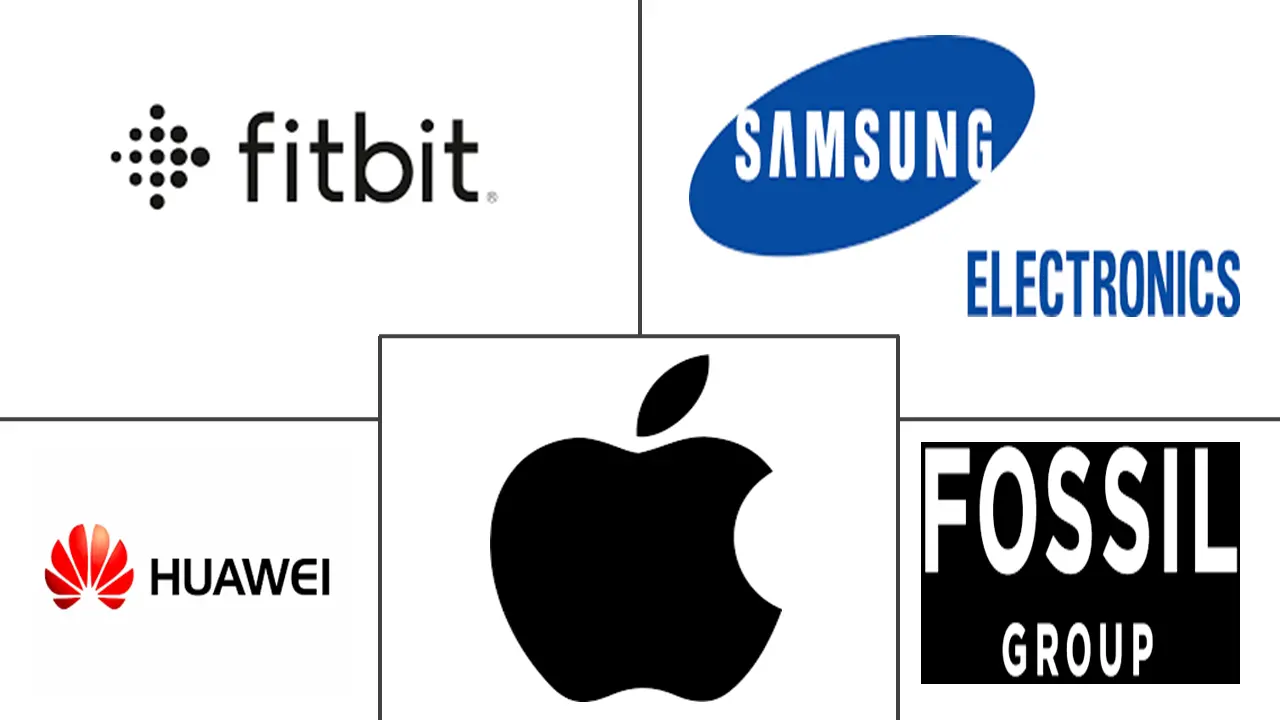Fitness Tracker Market Size and Share
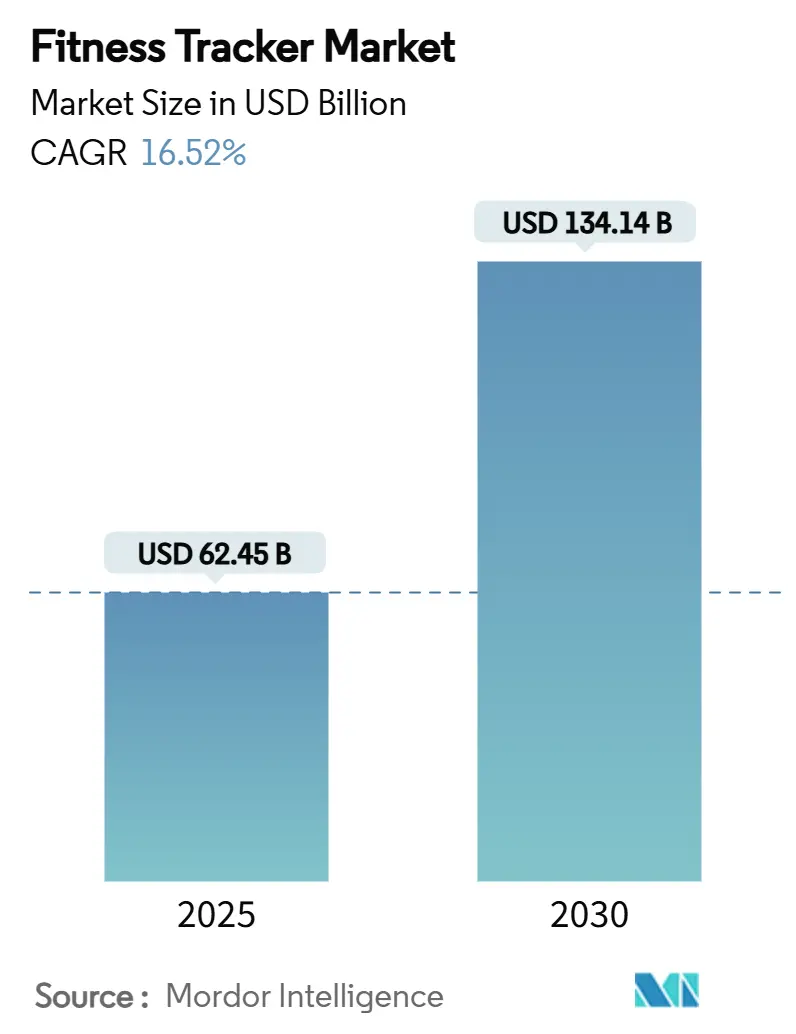
Fitness Tracker Market Analysis by Mordor Intelligence
The global fitness tracker market stood at USD 62.45 billion in 2025 and is forecast to reach USD 134.14 billion by 2030, advancing at a 16.52% CAGR. Demand is shifting from simple step counters toward medical-grade platforms that combine continuous glucose sensing, AI-driven biometric analytics, and digital-therapeutics connectivity. Employer wellness incentives, payer reimbursement codes for digital health, and over-the-counter (OTC) clearances for continuous glucose monitors (CGMs) accelerate device adoption. Smartwatches remain the anchor form factor, yet distributed sensing in clothing, rings, and footwear broadens addressable use cases. Regulatory emphasis on cybersecurity and circular-economy design raises compliance costs but stimulates innovation in secure data architecture and recyclable materials.
Key Report Takeaways
- By product type, smartwatches led with 47.55% revenue share in 2024; smart clothing and shoes are projected to expand at a 22.25% CAGR to 2030.
- By sales channel, the online segment held 64.53% of the fitness tracker market share in 2024, while it is also expected to post the highest 18.85% CAGR through 2030.
- By wearing type, hand-wear devices captured 85.12% share of the fitness tracker market size in 2024 and leg-wear is forecast to grow at 22.31% CAGR over the same period.
- By application, heart-rate and activity monitoring accounted for 39.63% share of the fitness tracker market size in 2024; glucose and metabolic tracking is advancing at a 20.27% CAGR through 2030.
- By geography, North America dominated with 43.63% share in 2024, whereas Asia-Pacific is set to record the quickest 19.87% CAGR to 2030.
Global Fitness Tracker Market Trends and Insights
Drivers Impact Analysis
| Driver | (~) % Impact on CAGR Forecast | Geographic Relevance | Impact Timeline |
|---|---|---|---|
| Growing adoption of smartwatches as health hubs | +3.2% | Global; strongest in North America and EU | Medium term (2-4 years) |
| AI-powered biometric sensors in mass-market bands | +2.8% | APAC manufacturing, global diffusion | Short term (≤ 2 years) |
| Insurer and employer wellness incentives | +2.1% | North America and EU, emerging in APAC | Medium term (2-4 years) |
| Continuous non-invasive glucose sensing | +4.3% | Global; US regulatory leadership | Long term (≥ 4 years) |
| Expansion of women-specific analytics | +1.9% | Advanced economies | Medium term (2-4 years) |
| Digital-therapeutics reimbursement integration | +2.4% | North America primary, selective EU markets | Long term (≥ 4 years) |
| Source: Mordor Intelligence | |||
Growing Adoption of Smartwatches as All-in-One Health Hubs
Smartwatches now embed ECG, SpO₂, skin-temperature, and impending blood-pressure sensors, offering a consolidated monitoring package that reduces device fatigue. Apple plans to launch cuff-less blood-pressure alerts in its fall 2025 lineup, while Samsung introduced wrist-based glucose trend readings in 2024. Health systems view the single-device model as a cost-effective way to promote continuous patient compliance. Ecosystem lock-in through app stores, cloud back-ups, and family-sharing dashboards reinforces vendor stickiness, allowing premium brands to defend margin even as component prices decline. Corporate wellness contracts that subsidize devices drive volume in commercial channels and further validate smartwatches as essential rather than discretionary purchases.
Penetration of AI-Powered Biometric Sensors in Mass-Market Bands
Edge AI chips now ship inside sub-USD 100 wristbands, bringing medical-grade resolution to mid-tier price points. Textile-embedded processors from Cornell and MIT achieve over 93% activity-classification accuracy in laboratory trials, signaling broader migration from wrist to garment fabric. On-device inference reduces latency, avoids costly cloud calls, and satisfies data-sovereignty mandates in Europe and parts of Asia. Low-cost accuracy lifts replacement cycles in price-sensitive markets, directly expanding the fitness tracker market without cannibalizing premium categories. Component standardization also shortens design cycles, letting regional OEMs pivot products toward hyper-local health concerns such as air-quality alerts or dengue-fever symptom flags.
Shift To Continuous Non-Invasive Glucose Sensing Wearables
The U.S. FDA cleared the first over-the-counter continuous glucose monitor in March 2024, creating a consumer channel that no longer requires a prescription for Type 2 diabetics or wellness users. Dexcom’s Stelo led this shift, followed by Abbott’s Lingo and Libre Rio systems three months later, firmly positioning CGMs inside the broader fitness tracker market. Major smartwatch makers now race to embed optical glucose technology so users can see metabolic trends without a separate patch sensor; Samsung filed patents for a wrist-based approach in 2024 that aims to meet accuracy targets flagged by regulators. Hardware integration reduces daily friction, lets apps correlate activity and sleep against glucose curves, and expands preventive care programs that reward stable readings. As component costs fall, manufacturers plan sub-USD 200 wearables that bundle glucose insights with heart-rate, SpO₂, and temperature tracking, moving the device from lifestyle accessory to essential metabolic dashboard.
Integration With Digital Therapeutics Reimbursement Pathways
The Centers for Medicare & Medicaid Services proposed new CPT codes GMBT1-3 in 2024, allowing clinicians to bill for prescribing and managing software-based therapies that rely on wearable data streams. This formal pathway shifts revenue models from one-time device sales toward recurring fees tied to clinical outcomes captured by fitness trackers. The FDA’s enforcement-discretion policy for low-risk digital health products further accelerates market entry because companies can iterate software without a lengthy 510(k) cycle while still meeting safety expectations. Health-system pilots show that merging tracker data with electronic health records improves remote coaching efficiency and reduces readmissions for cardiometabolic patients, strengthening payer interest. Manufacturers now bundle subscription platforms that flag deteriorating vitals and trigger telehealth visits, creating a reimbursable loop that aligns patient engagement with insurer cost savings.
Restraints Impact Analysis
| Restraint | (~) % Impact on CAGR Forecast | Geographic Relevance | Impact Timeline |
|---|---|---|---|
| High average selling price of flagship smartwatches | -1.8% | Global premium segments | Short term (≤ 2 years) |
| Cyber-security and data-sovereignty compliance costs | -2.1% | EU first, expanding worldwide | Medium term (2-4 years) |
| Sensor-skin contact dermatitis | -0.9% | Humid markets | Short term (≤ 2 years) |
| Growing e-waste regulation | -1.4% | EU leadership, rolling into APAC | Long term (≥ 4 years) |
| Source: Mordor Intelligence | |||
Cyber-Security and Data-Sovereignty Compliance Costs
Europe’s Cyber Resilience Act obliges manufacturers to conduct vulnerability testing, issue five-year security patches, and disclose breaches within 24 hours. Mid-cap brands face higher certification costs and longer development cycles, slowing product refresh rates and constraining choice for consumers[1]Cédric Burton, Laura Brodahl, Jessica O'Neill, “New EU Cybersecurity Obligations for Connected Devices: What You Need to Know,” wsgr.com. Parallel GDPR enforcement increases fines for data misuse, prompting firms to build region-specific data centers that raise operating expense. In North America, fragmented privacy statutes complicate a unified compliance roadmap, leading some vendors to adopt the strictest standard globally, raising BOM costs by an estimated 3% per unit. While robust security boosts consumer confidence, the near-term financial burden weighs on operating margins and may deter smaller entrants from scaling in multiple regions.
Growing E-Waste Regulation Elevating End-of-Life Costs
The EU Regulation 2024/1781 bans destruction of unsold stock, mandates digital product passports, and enforces durability benchmarks such as battery swapability[2]European Parliament and Council, “Regulation - EU - 2024/1781 - EN,” eur-lex.europa.eu. Original-design manufacturers must re-engineer casings for disassembly, adding tooling investments and lengthening supply-chain lead times. Device buy-back schemes become obligatory, shifting logistics complexity onto brands that historically off-loaded inventory risk to retailers. Extended producer-responsibility fees could erode price competitiveness of low-margin fitness bands. Nonetheless, compliance can become a differentiator as sustainability metrics grow in purchasing criteria for corporate wellness buyers and public procurement tenders.
Segment Analysis
By Product Type: Smartwatches Drive Ecosystem Integration
Smartwatches accounted for 47.55% of the fitness tracker market size in 2024, benefitting from tight linkage to smartphone operating systems and a deep bench of health apps. Sensor fusion inside flagship models elevates them to quasi-diagnostic devices that can export structured data straight into electronic health records. Entry-level smartwatches with pared-down displays capture value-conscious users while still feeding cloud algorithms that upsell premium analytics tiers.
Smart clothing and shoes post the fastest 22.25% CAGR to 2030 on the back of conductive fabrics that withstand machine washing and deliver 95% activity-recognition accuracy. Athletics brands bundle gait-analysis subscriptions with footwear to monetize beyond the initial sale. Smart rings fill a privacy-and-comfort niche, appealing to night-time wearers who dislike wrist straps. These alternative form factors collectively expand the fitness tracker market by addressing contexts where wrist-wear proves intrusive or imprecise.
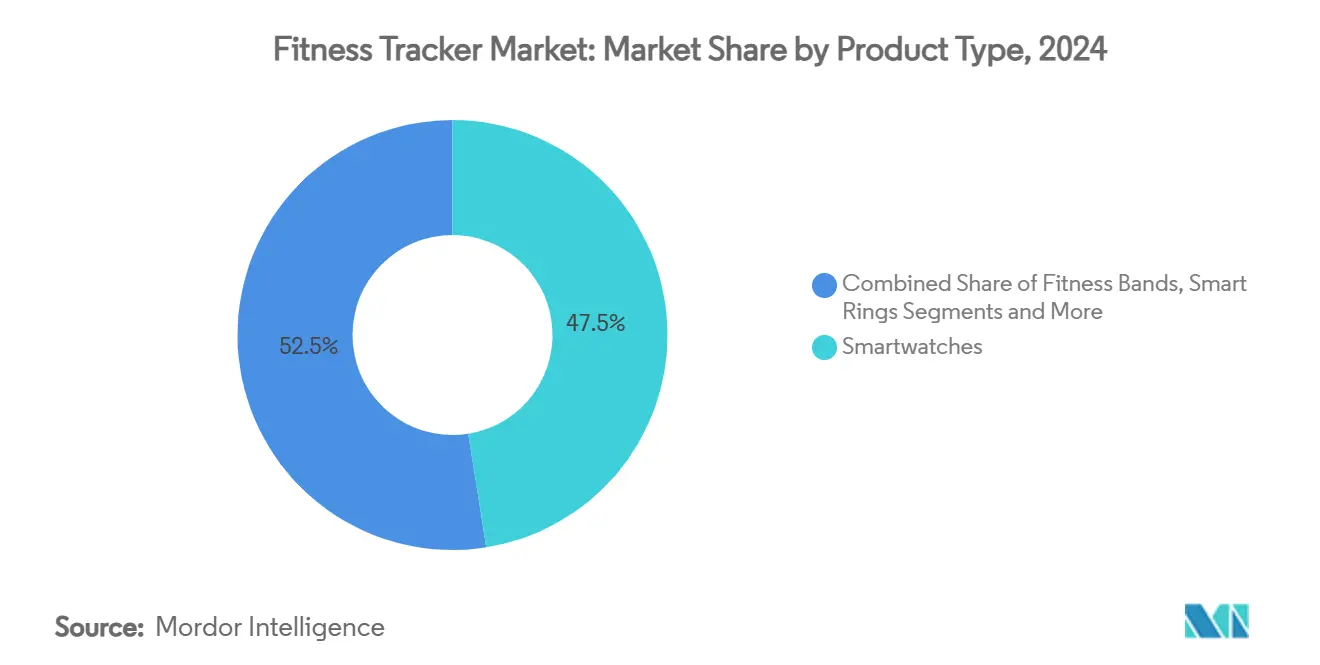
Note: Segment shares of all individual segments available upon report purchase
By Sales Channel: Online Dominance Accelerates Direct Engagement
E-commerce captured 64.53% of the fitness tracker market share in 2024, propelled by livestreamed product demos, influencer unboxings, and integrated financing at checkout. Direct-to-consumer portals allow brands to push firmware updates, sell coaching plans, and harvest anonymized engagement metrics without retailer mark-ups. Return-rate friction drops as virtual-try-on tools mature.
Offline specialty chains retain relevance for premium positioning, experiential displays, and immediate fulfillment during holiday peaks, but their share erodes as logistics partners enable two-day doorstep delivery even in secondary cities. Hybrid click-and-collect models emerge in pharmacies, marrying the medical credibility of brick-and-mortar with digital convenience.
By Wearing Type: Hand-wear Dominance Faces Emerging Alternatives
Hand-wear devices, including watches and rings, represented 85.12% of the fitness tracker market size in 2024. The wrist remains ideal for pulse, motion, and temperature capture, and finger-based photoplethysmography enhances nocturnal HRV precision.
Leg-wear grows fastest at 22.31% CAGR as embedded insoles quantify pronation, pressure distribution, and caloric expenditure. Sports-science insights from foot strikes unlock upsell paths for personalized training plans. Head-wear and torso-wear stay niche for now, serving sleep-lab substitutes and continuous vital-sign capture in home-care settings. Multisensor redundancy across body locations improves data fidelity and positions apparel brands as new health-data gatekeepers.
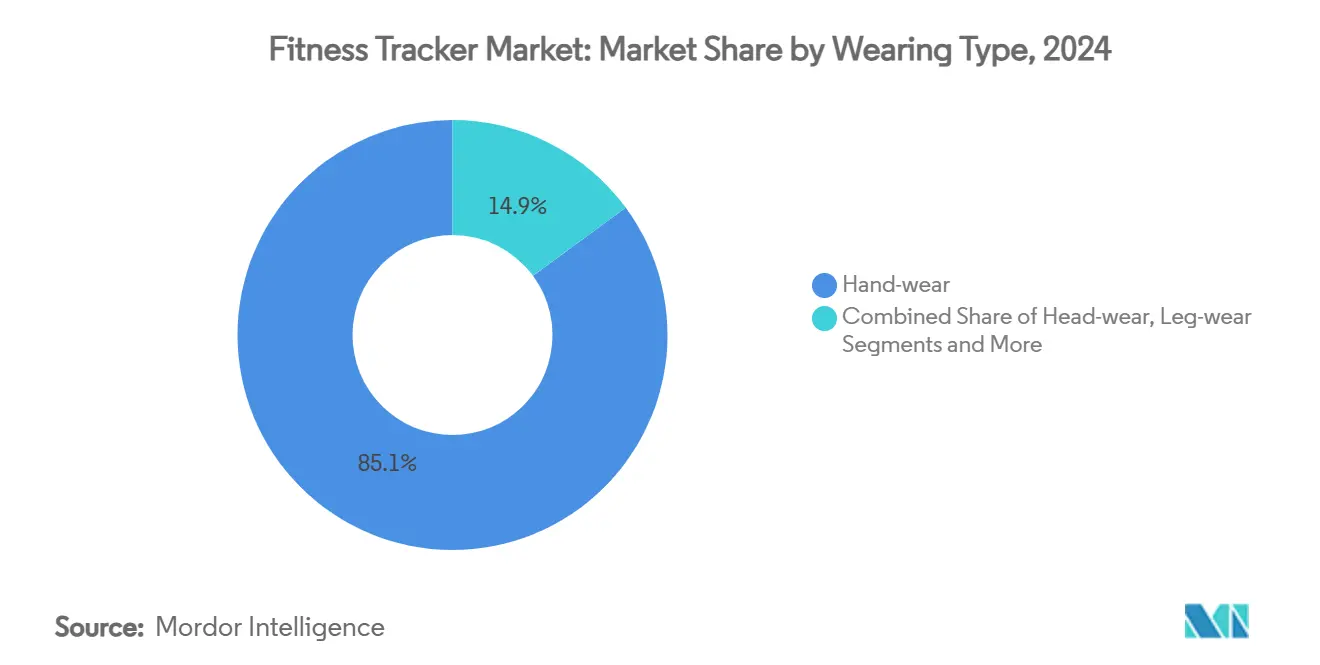
Note: Segment shares of all individual segments available upon report purchase
By Application: Glucose Tracking Emerges as Growth Driver
Heart-rate and activity monitoring kept 39.63% share of the fitness tracker market size in 2024, retaining mass appeal through real-time feedback loops that reinforce daily exercise habits. The segment underpins downstream services such as insurance premium reductions and workplace incentive programs.
Glucose and metabolic tracking is forecast to grow at 20.27% CAGR after FDA OTC CGM clearance opened the door to non-insulin Type 2 diabetics and wellness users. Correlating glucose curves with sleep and activity unlocks holistic metabolic-health dashboards. Sleep-quality, women’s-health, and senior-safety applications diversify revenue, assuring the fitness tracker market of sustained multi-segment momentum.
Geography Analysis
North America commanded 43.63% share in 2024. Employer wellness programs that pay up to USD 1,000 annually for meeting device-verified goals demonstrate financial alignment between insurers and preventive care[3]UnitedHealthcare, “Members may earn hundreds per year for reaching program health and activity goals,” uhc.com. CMS’s proposed CPT codes for digital therapeutics cement a reimbursement pathway, encouraging clinicians to prescribe tracker-based interventions. The litany of FDA 510(k) and OTC clearances for wearable sensors further legitimizes devices as front-line medical tools. Venture capital continues to flow into AI-driven analytics startups that plug into smartwatch APIs.
Asia-Pacific grows fastest at 19.87% CAGR, fueled by vertically integrated manufacturing clusters that compress production costs and enable rapid SKU proliferation. Local brands bundle vernacular language coaching and tailored diet insights, resonating with first-time buyers in India, Indonesia, and China. Rising middle-class disposable income aligns with government campaigns promoting active lifestyles to combat urban sedentary trends. Domestic tech giants leverage super-apps to cross-sell wearables, insurance, and telemedicine-consult packages.
Europe registers steady growth underpinned by robust consumer-data protections that build trust in cloud-synced biometrics. Compliance with the Cyber Resilience Act drives up-front R&D spend yet culls lower-quality imports, raising average selling prices. Public-sector procurement in Germany and the Nordics increasingly specifies EU-origin devices that meet recyclability quotas. Southern European markets lag slightly due to lower discretionary income but benefit from pan-EU e-commerce fulfillment.
The Middle East, Africa, and South America illustrate leap-frog potential as mobile-first populations adopt affordable bands bundled with prepaid data plans. Government-sponsored chronic-disease screening in the Gulf states includes optional tracker distribution, and Brazilian digital-bank loyalty programs reward steps with cashback. Power-supply variability and broadband gaps remain barriers yet decline as infrastructure improves.
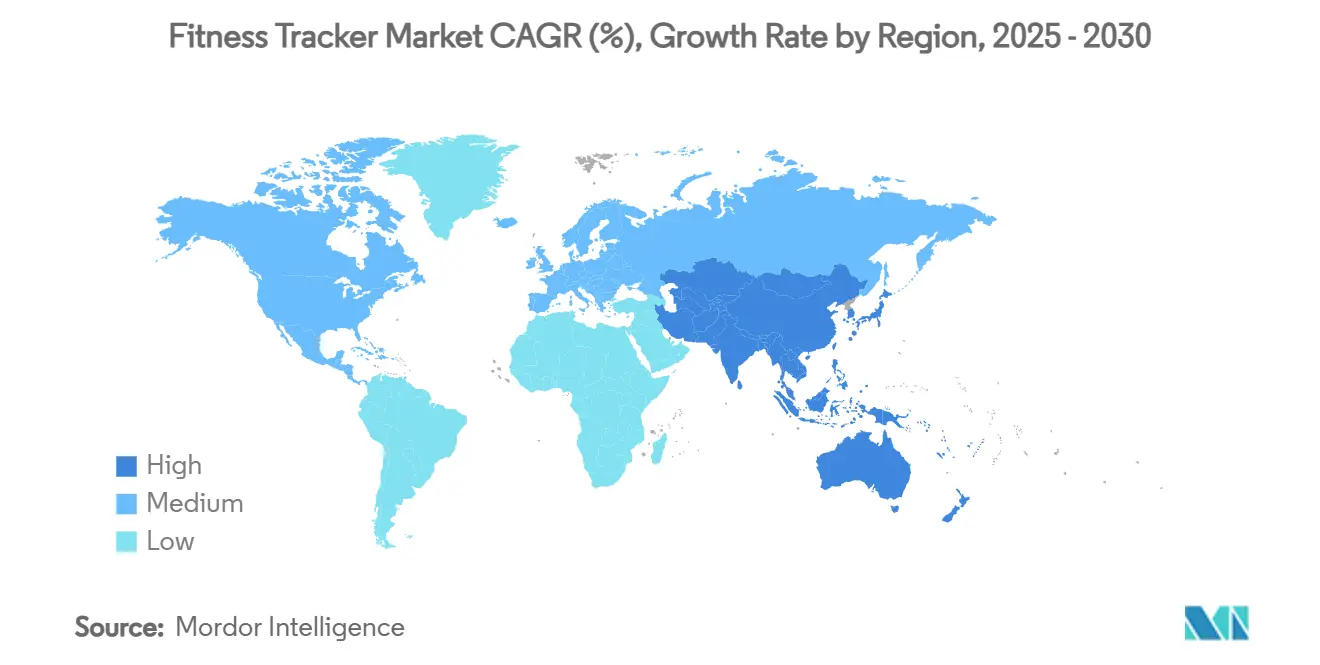
Competitive Landscape
Market concentration is moderate. Apple and Samsung leverage proprietary silicon, OS integration, and multi-device ecosystems, anchoring the high-end segment. Garmin focuses on endurance athletes, offering multi-band GPS and two-week battery life, while Dexcom and Abbott target medical CGM integration. Specialized entrants such as Oura, Whoop, and Ultrahuman carve out niches in sleep, recovery, and metabolic fitness, monetizing via subscription dashboards rather than hardware margin.
Patent litigation intensifies; Samsung’s preemptive suit against Oura over smart-ring IP illustrates defensive tactics to avoid injunctions that could derail new form factors. Partnerships bridge gaps between consumer electronics and regulated med-tech: Dexcom invested USD 75 million in Oura to co-develop ring-CGM data fusion, signaling cross-category synergies.
Players also race to comply with circular-economy mandates. Garmin introduced a refurbishment program that extends product life to six years, and Apple expanded self-service repair to its watch line. Regional challengers in India and China undercut on price using local supply chains, yet often struggle with international cybersecurity certifications, limiting export potential.
Fitness Tracker Industry Leaders
-
Apple, Inc.
-
Samsung Electronics Co. Ltd
-
Fossil Group Inc.
-
Huawei Technologies Co. Ltd
-
Google (Fitbit)
- *Disclaimer: Major Players sorted in no particular order
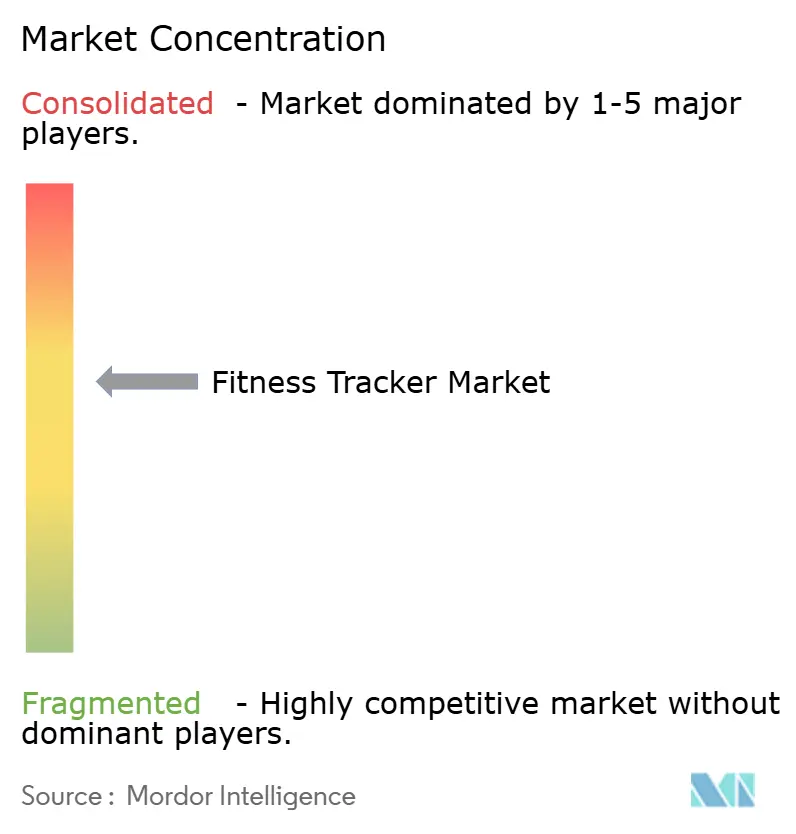
Recent Industry Developments
- January 2025: Apple confirmed upcoming Watch Series 11 and Ultra 3 models will provide wrist-based blood-pressure alerts.
- July 2024: Samsung debuted the Galaxy Ring at USD 399, delivering sleep, heart-rate, and menstrual analytics in a 3 g form factor with seven-day battery life.
Global Fitness Tracker Market Report Scope
As per the scope of this report, a fitness tracker is a wearable gadget or a computer application that records a person's daily physical activity as well as other fitness or health statistics such as calories burnt, heart rate, and oxygen level among others. The fitness tracker market is segmented by Product Type (Fitness Band, Smart Watches, and Others), By Sales Channel (Offline and Online), By Wearing Type (Hand Wear, Leg Wear, Head Wear, and Others), By Application (Heart Rate Monitoring, Sleep Measurement, Glucose Measurement, and Others), and Geography (North America, Europe, Asia-Pacific, Middle East, and Africa, and South America). The market report also covers the estimated market sizes and trends for 17 different countries across major regions, globally. The report offers the value (in USD million) for the above segments.
| Fitness Bands |
| Smartwatches |
| Smart Rings |
| Smart Clothing & Shoes |
| Others |
| Online |
| Offline (Specialty Retail, CE Stores) |
| Hand-wear (Wrist- & Finger-based) |
| Head-wear |
| Leg-wear (Smart Shoes, Straps) |
| Torso-wear (Smart Shirts) |
| Others |
| Heart-rate & Activity Monitoring |
| Sleep & Recovery Analysis |
| Glucose & Metabolic Tracking |
| Women's Health & Fertility |
| Occupational & Senior Safety |
| North America | United States |
| Canada | |
| Mexico | |
| Europe | Germany |
| United Kingdom | |
| France | |
| Italy | |
| Spain | |
| Rest of Europe | |
| Asia-Pacific | China |
| Japan | |
| India | |
| South Korea | |
| Australia | |
| Rest of Asia-Pacific | |
| Middle East and Africa | GCC |
| South Africa | |
| Rest of Middle East and Africa | |
| South America | Brazil |
| Argentina | |
| Rest of South America |
| By Product Type | Fitness Bands | |
| Smartwatches | ||
| Smart Rings | ||
| Smart Clothing & Shoes | ||
| Others | ||
| By Sales Channel | Online | |
| Offline (Specialty Retail, CE Stores) | ||
| By Wearing Type | Hand-wear (Wrist- & Finger-based) | |
| Head-wear | ||
| Leg-wear (Smart Shoes, Straps) | ||
| Torso-wear (Smart Shirts) | ||
| Others | ||
| By Application | Heart-rate & Activity Monitoring | |
| Sleep & Recovery Analysis | ||
| Glucose & Metabolic Tracking | ||
| Women's Health & Fertility | ||
| Occupational & Senior Safety | ||
| Geography | North America | United States |
| Canada | ||
| Mexico | ||
| Europe | Germany | |
| United Kingdom | ||
| France | ||
| Italy | ||
| Spain | ||
| Rest of Europe | ||
| Asia-Pacific | China | |
| Japan | ||
| India | ||
| South Korea | ||
| Australia | ||
| Rest of Asia-Pacific | ||
| Middle East and Africa | GCC | |
| South Africa | ||
| Rest of Middle East and Africa | ||
| South America | Brazil | |
| Argentina | ||
| Rest of South America | ||
Key Questions Answered in the Report
What is the current market size of the fitness tracker market?
The market reached USD 62.45 billion in 2025 and is projected to climb to USD 134.14 billion by 2030.
Which product segment holds the largest fitness tracker market share today?
Smartwatches lead, accounting for 47.55% of 2024 revenue.
Why is glucose monitoring considered the fastest-growing application?
OTC clearance for continuous glucose monitors in the United States and Europe opened the category to non-insulin users, spurring a 20.27% CAGR outlook through 2030.
Which region will grow the quickest over the forecast period?
Asia-Pacific is expected to post a 19.87% CAGR, driven by cost-efficient manufacturing and rising health awareness among expanding middle classes.
Page last updated on:
